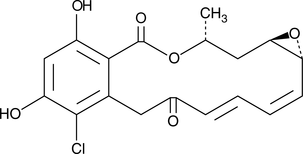Chemicals
Showing 33751–33900 of 41137 results
-
Arachidonoyl ethanolamide (AEA) was the first endogenous cannabinoid (CB) to be isolated and characterized as an agonist acting on the same receptors (CB1 and CB2) as Δ9-THC.{1134,2713} Since that time, a number of related endocannabinoids have been isolated, most notably 2-arachidonoyl glycerol (2-AG).{2713} The phosphate ester of R-1 methanandamide, R-1MAP, has been tested as a water soluble prodrug analog of AEA.{11520} The activity of R-1MAP was essentially equivalent to that of AEA in the growth inhibition of C6 glioma cells. However, when tested for inhibition of AEA binding to isolated rat brain CB1 receptors, arachidonoyl ethanolamide phosphate (AEA-P) is about 5-fold less potent as an agonist with a Ki of about 200 nM.{9580} The phosphate esters of AEA and its analogs are also structural variants of lysophosphatidic acid (LPA). However, the effects of R-1MAP on the various LPA receptors have not been tested.
Brand:CaymanSKU:10004281 - 5 mgAvailable on backorder
R-2 methanandamide is a cannabinoid analog with a methyl group in the (R) configuration at C-2 of the ethanolamine group. In contrast to the other methyl-anandamide analogs, R-2 methanandamide is not an amidohydrolase inhibitor and is nearly as susceptible to amide hydrolysis as AEA itself.{1092}
Brand:CaymanSKU:90074 - 10 mgAvailable on backorder
R-2 methanandamide is a cannabinoid analog with a methyl group in the (R) configuration at C-2 of the ethanolamine group. In contrast to the other methyl-anandamide analogs, R-2 methanandamide is not an amidohydrolase inhibitor and is nearly as susceptible to amide hydrolysis as AEA itself.{1092}
Brand:CaymanSKU:90074 - 25 mgAvailable on backorder
R-2 methanandamide is a cannabinoid analog with a methyl group in the (R) configuration at C-2 of the ethanolamine group. In contrast to the other methyl-anandamide analogs, R-2 methanandamide is not an amidohydrolase inhibitor and is nearly as susceptible to amide hydrolysis as AEA itself.{1092}
Brand:CaymanSKU:90074 - 5 mgAvailable on backorder
Calcium-sensing receptor (CaSR) is a G protein-coupled receptor that is involved in calcium homeostasis.{29237,26276} Activation of CaSR on parathyroid cells decreases the secretion of parathyroid hormone (PTH), which in turn reduces blood calcium concentration.{29237,26276} R-568 is a calcimimetic compound that can allosterically activate or positively modulate the human CaSR.{30711,30710,26280} It dose-dependently decreases circulating levels of PTH in both normal individuals and patients with primary hyperparathyroidism in clinical trials.{30711} R-568 is used in research to explore novel actions of CaSR.{30709,30708}
Brand:CaymanSKU:-Available on backorder
Calcium-sensing receptor (CaSR) is a G protein-coupled receptor that is involved in calcium homeostasis.{29237,26276} Activation of CaSR on parathyroid cells decreases the secretion of parathyroid hormone (PTH), which in turn reduces blood calcium concentration.{29237,26276} R-568 is a calcimimetic compound that can allosterically activate or positively modulate the human CaSR.{30711,30710,26280} It dose-dependently decreases circulating levels of PTH in both normal individuals and patients with primary hyperparathyroidism in clinical trials.{30711} R-568 is used in research to explore novel actions of CaSR.{30709,30708}
Brand:CaymanSKU:-Available on backorder
Calcium-sensing receptor (CaSR) is a G protein-coupled receptor that is involved in calcium homeostasis.{29237,26276} Activation of CaSR on parathyroid cells decreases the secretion of parathyroid hormone (PTH), which in turn reduces blood calcium concentration.{29237,26276} R-568 is a calcimimetic compound that can allosterically activate or positively modulate the human CaSR.{30711,30710,26280} It dose-dependently decreases circulating levels of PTH in both normal individuals and patients with primary hyperparathyroidism in clinical trials.{30711} R-568 is used in research to explore novel actions of CaSR.{30709,30708}
Brand:CaymanSKU:-Available on backorder
Calcium-sensing receptor (CaSR) is a G protein-coupled receptor that is involved in calcium homeostasis.{29237,26276} Activation of CaSR on parathyroid cells decreases the secretion of parathyroid hormone (PTH), which in turn reduces blood calcium concentration.{29237,26276} R-568 is a calcimimetic compound that can allosterically activate or positively modulate the human CaSR.{30711,30710,26280} It dose-dependently decreases circulating levels of PTH in both normal individuals and patients with primary hyperparathyroidism in clinical trials.{30711} R-568 is used in research to explore novel actions of CaSR.{30709,30708}
Brand:CaymanSKU:-Available on backorder
Diacylglycerol (DAG) kinases (DGKs) phosphorylate DAG to give phosphatidic acid (PA), reducing signaling through DAG and increasing signaling through PA.{7274} R-59-022 is an inhibitor of DGK (IC50 = 2.8 µM).{27715} This results in increased DAG-dependent PKC activity and potentiates aggregation of thrombin-stimulated platelets.{27715,27713} R-59-022 also blocks vascular contraction induced by the thromboxane analog U-46619 (Item No. 16450).{27712} At 10 µM, R-59-022 induces apoptosis in glioblastoma cells without being toxic to non-cancerous cells.{27710} It inhibits DGK-θ in vitro at concentrations below 1 µM and blocks DGK-θ activity in vivo.{27714} R-59-022 also inhibits A. thaliana DGK2 (IC50 = 50 µM) and suppresses root growth but does not affect DGK7 at 50 µM.{27711}
Brand:CaymanSKU:-Out of stock
Diacylglycerol (DAG) kinases (DGKs) phosphorylate DAG to give phosphatidic acid (PA), reducing signaling through DAG and increasing signaling through PA.{7274} R-59-022 is an inhibitor of DGK (IC50 = 2.8 µM).{27715} This results in increased DAG-dependent PKC activity and potentiates aggregation of thrombin-stimulated platelets.{27715,27713} R-59-022 also blocks vascular contraction induced by the thromboxane analog U-46619 (Item No. 16450).{27712} At 10 µM, R-59-022 induces apoptosis in glioblastoma cells without being toxic to non-cancerous cells.{27710} It inhibits DGK-θ in vitro at concentrations below 1 µM and blocks DGK-θ activity in vivo.{27714} R-59-022 also inhibits A. thaliana DGK2 (IC50 = 50 µM) and suppresses root growth but does not affect DGK7 at 50 µM.{27711}
Brand:CaymanSKU:-Out of stock
Diacylglycerol (DAG) kinases (DGKs) phosphorylate DAG to give phosphatidic acid (PA), reducing signaling through DAG and increasing signaling through PA.{7274} R-59-022 is an inhibitor of DGK (IC50 = 2.8 µM).{27715} This results in increased DAG-dependent PKC activity and potentiates aggregation of thrombin-stimulated platelets.{27715,27713} R-59-022 also blocks vascular contraction induced by the thromboxane analog U-46619 (Item No. 16450).{27712} At 10 µM, R-59-022 induces apoptosis in glioblastoma cells without being toxic to non-cancerous cells.{27710} It inhibits DGK-θ in vitro at concentrations below 1 µM and blocks DGK-θ activity in vivo.{27714} R-59-022 also inhibits A. thaliana DGK2 (IC50 = 50 µM) and suppresses root growth but does not affect DGK7 at 50 µM.{27711}
Brand:CaymanSKU:-Out of stock
Diacylglycerol (DAG) kinases (DGKs) phosphorylate DAG to give phosphatidic acid (PA), reducing signaling through DAG and increasing signaling through PA.{7274} R-59-022 is an inhibitor of DGK (IC50 = 2.8 µM).{27715} This results in increased DAG-dependent PKC activity and potentiates aggregation of thrombin-stimulated platelets.{27715,27713} R-59-022 also blocks vascular contraction induced by the thromboxane analog U-46619 (Item No. 16450).{27712} At 10 µM, R-59-022 induces apoptosis in glioblastoma cells without being toxic to non-cancerous cells.{27710} It inhibits DGK-θ in vitro at concentrations below 1 µM and blocks DGK-θ activity in vivo.{27714} R-59-022 also inhibits A. thaliana DGK2 (IC50 = 50 µM) and suppresses root growth but does not affect DGK7 at 50 µM.{27711}
Brand:CaymanSKU:-Out of stock
R-59-949 is an inhibitor of diacylglycerol kinase α (DGK-α) with an IC50 value of 300 nM in isolated platelet plasma membranes using exogenous diacylglycerol as a substrate.{39236} DGK-α inhibition with R-59-949 increases diacylglycerol-dependent PKC activity, serotonin secretion, and aggregation of thrombin-stimulated platelets. R-59-949 inhibits DGK-α activity induced by platelet-derived growth factor (PDGF) in intact vascular smooth muscle cells (VSMCs).{39237} It inhibits high K+- and glucose-induced insulin secretion in MIN6 pancreatic β-cells in a dose-dependent manner.{39238} In vivo, administration of R-59-949 prevents retinal neovascularization in a mouse model of oxygen-induced retinopathy.{39239}
Brand:CaymanSKU:21221 -Out of stock
R-59-949 is an inhibitor of diacylglycerol kinase α (DGK-α) with an IC50 value of 300 nM in isolated platelet plasma membranes using exogenous diacylglycerol as a substrate.{39236} DGK-α inhibition with R-59-949 increases diacylglycerol-dependent PKC activity, serotonin secretion, and aggregation of thrombin-stimulated platelets. R-59-949 inhibits DGK-α activity induced by platelet-derived growth factor (PDGF) in intact vascular smooth muscle cells (VSMCs).{39237} It inhibits high K+- and glucose-induced insulin secretion in MIN6 pancreatic β-cells in a dose-dependent manner.{39238} In vivo, administration of R-59-949 prevents retinal neovascularization in a mouse model of oxygen-induced retinopathy.{39239}
Brand:CaymanSKU:21221 -Out of stock
R-59-949 is an inhibitor of diacylglycerol kinase α (DGK-α) with an IC50 value of 300 nM in isolated platelet plasma membranes using exogenous diacylglycerol as a substrate.{39236} DGK-α inhibition with R-59-949 increases diacylglycerol-dependent PKC activity, serotonin secretion, and aggregation of thrombin-stimulated platelets. R-59-949 inhibits DGK-α activity induced by platelet-derived growth factor (PDGF) in intact vascular smooth muscle cells (VSMCs).{39237} It inhibits high K+- and glucose-induced insulin secretion in MIN6 pancreatic β-cells in a dose-dependent manner.{39238} In vivo, administration of R-59-949 prevents retinal neovascularization in a mouse model of oxygen-induced retinopathy.{39239}
Brand:CaymanSKU:21221 -Out of stock
R-59-949 is an inhibitor of diacylglycerol kinase α (DGK-α) with an IC50 value of 300 nM in isolated platelet plasma membranes using exogenous diacylglycerol as a substrate.{39236} DGK-α inhibition with R-59-949 increases diacylglycerol-dependent PKC activity, serotonin secretion, and aggregation of thrombin-stimulated platelets. R-59-949 inhibits DGK-α activity induced by platelet-derived growth factor (PDGF) in intact vascular smooth muscle cells (VSMCs).{39237} It inhibits high K+- and glucose-induced insulin secretion in MIN6 pancreatic β-cells in a dose-dependent manner.{39238} In vivo, administration of R-59-949 prevents retinal neovascularization in a mouse model of oxygen-induced retinopathy.{39239}
Brand:CaymanSKU:21221 -Out of stock
R-7050 is a cell-permeable antagonist of signaling through the TNF-α receptor complex (EC50 = 0.631 µM).{27910} It blocks TNF-α-induced binding of TNF-α receptor I with TNF-α receptor-associated death domain protein and receptor interacting protein 1, which, in turn, prevents internalization of the receptor complex.{27910} R-7050 is 2.3-fold more selective for TNF-α-mediated signaling than for that driven by IL-1β.{27910} It has been used to investigate the role of TNF-α in neurovascular injury and mycotoxin-induced anorexia.{27911,27912}
Brand:CaymanSKU:-Out of stock
R-7050 is a cell-permeable antagonist of signaling through the TNF-α receptor complex (EC50 = 0.631 µM).{27910} It blocks TNF-α-induced binding of TNF-α receptor I with TNF-α receptor-associated death domain protein and receptor interacting protein 1, which, in turn, prevents internalization of the receptor complex.{27910} R-7050 is 2.3-fold more selective for TNF-α-mediated signaling than for that driven by IL-1β.{27910} It has been used to investigate the role of TNF-α in neurovascular injury and mycotoxin-induced anorexia.{27911,27912}
Brand:CaymanSKU:-Out of stock
R-7050 is a cell-permeable antagonist of signaling through the TNF-α receptor complex (EC50 = 0.631 µM).{27910} It blocks TNF-α-induced binding of TNF-α receptor I with TNF-α receptor-associated death domain protein and receptor interacting protein 1, which, in turn, prevents internalization of the receptor complex.{27910} R-7050 is 2.3-fold more selective for TNF-α-mediated signaling than for that driven by IL-1β.{27910} It has been used to investigate the role of TNF-α in neurovascular injury and mycotoxin-induced anorexia.{27911,27912}
Brand:CaymanSKU:-Out of stock
R-7050 is a cell-permeable antagonist of signaling through the TNF-α receptor complex (EC50 = 0.631 µM).{27910} It blocks TNF-α-induced binding of TNF-α receptor I with TNF-α receptor-associated death domain protein and receptor interacting protein 1, which, in turn, prevents internalization of the receptor complex.{27910} R-7050 is 2.3-fold more selective for TNF-α-mediated signaling than for that driven by IL-1β.{27910} It has been used to investigate the role of TNF-α in neurovascular injury and mycotoxin-induced anorexia.{27911,27912}
Brand:CaymanSKU:-Out of stock
R-848 is an immune response modifier that mimics the pathogen-associated molecular patterns that activate immune cells through Toll-like receptor 7 (TLR7) and TLR8. It demonstrates potent anti-tumor and anti-viral properties and has been used to study the innate immune response to viral infections. {23569,23568,23572} At 1 μg/ml, R-848 mimics CD40-induced B cell activation and can be used to induce the production of IFN-γ and various other cytokines.{23570,23571}
Brand:CaymanSKU:-R-848 is an immune response modifier that mimics the pathogen-associated molecular patterns that activate immune cells through Toll-like receptor 7 (TLR7) and TLR8. It demonstrates potent anti-tumor and anti-viral properties and has been used to study the innate immune response to viral infections. {23569,23568,23572} At 1 μg/ml, R-848 mimics CD40-induced B cell activation and can be used to induce the production of IFN-γ and various other cytokines.{23570,23571}
Brand:CaymanSKU:-R-848 is an immune response modifier that mimics the pathogen-associated molecular patterns that activate immune cells through Toll-like receptor 7 (TLR7) and TLR8. It demonstrates potent anti-tumor and anti-viral properties and has been used to study the innate immune response to viral infections. {23569,23568,23572} At 1 μg/ml, R-848 mimics CD40-induced B cell activation and can be used to induce the production of IFN-γ and various other cytokines.{23570,23571}
Brand:CaymanSKU:-R-848 is an immune response modifier that mimics the pathogen-associated molecular patterns that activate immune cells through Toll-like receptor 7 (TLR7) and TLR8. It demonstrates potent anti-tumor and anti-viral properties and has been used to study the innate immune response to viral infections. {23569,23568,23572} At 1 μg/ml, R-848 mimics CD40-induced B cell activation and can be used to induce the production of IFN-γ and various other cytokines.{23570,23571}
Brand:CaymanSKU:-R-8507 is a small molecule antagonist of the TNF-α type 1 receptor (TNF-αRI).{27910} It inhibits the expression of intercellular adhesion molecule-1 (ICAM-1) induced by TNF-α and IL-1β with EC50 values of 2.45 and 3.79 µM, respectively, in an ELISA using A549 lung epithelial cells.{|Gururaja2007|} It also disrupts the interaction of the TNF-αRI with receptor interacting protein 1 (RIP1) and TNF-αR-associated death domain protein (TRADD), preventing internalization of the receptor complex.
Brand:CaymanSKU:22479 -Out of stock
R-8507 is a small molecule antagonist of the TNF-α type 1 receptor (TNF-αRI).{27910} It inhibits the expression of intercellular adhesion molecule-1 (ICAM-1) induced by TNF-α and IL-1β with EC50 values of 2.45 and 3.79 µM, respectively, in an ELISA using A549 lung epithelial cells.{|Gururaja2007|} It also disrupts the interaction of the TNF-αRI with receptor interacting protein 1 (RIP1) and TNF-αR-associated death domain protein (TRADD), preventing internalization of the receptor complex.
Brand:CaymanSKU:22479 -Out of stock
R-8507 is a small molecule antagonist of the TNF-α type 1 receptor (TNF-αRI).{27910} It inhibits the expression of intercellular adhesion molecule-1 (ICAM-1) induced by TNF-α and IL-1β with EC50 values of 2.45 and 3.79 µM, respectively, in an ELISA using A549 lung epithelial cells.{|Gururaja2007|} It also disrupts the interaction of the TNF-αRI with receptor interacting protein 1 (RIP1) and TNF-αR-associated death domain protein (TRADD), preventing internalization of the receptor complex.
Brand:CaymanSKU:22479 -Out of stock
R-8507 is a small molecule antagonist of the TNF-α type 1 receptor (TNF-αRI).{27910} It inhibits the expression of intercellular adhesion molecule-1 (ICAM-1) induced by TNF-α and IL-1β with EC50 values of 2.45 and 3.79 µM, respectively, in an ELISA using A549 lung epithelial cells.{|Gururaja2007|} It also disrupts the interaction of the TNF-αRI with receptor interacting protein 1 (RIP1) and TNF-αR-associated death domain protein (TRADD), preventing internalization of the receptor complex.
Brand:CaymanSKU:22479 -Out of stock
Palmitoyl ethanolamide (PEA) is an endogenous cannabinoid found in brain, liver, and other mammalian tissues.{2415} PEA has also been isolated from egg yolk, and found to have anti-anaphylactic and anti-inflammatory activity in vitro.{1633} R-Palmitoyl-(1-methyl) ethanolamide is a synthetic analog of PEA which incorporates an (R)-methyl group vicinal to the alcohol on the ethanolamine moiety. The analogous modification to arachidonoyl ethanolamide (AEA) protects the molecule from hydrolysis by fatty acid amide hydrolase. This leads to prolonged duration of action and enhanced potency in vivo.{1092} R-palmitoyl-(1-methyl) ethanolamide would be expected to show enhancement of the inhibitory action of PEA on mast cells and other cells known to express the CB2 receptor. However, there are no published studies on the use of this compound to date.
Brand:CaymanSKU:90353 - 10 mgAvailable on backorder
Palmitoyl ethanolamide (PEA) is an endogenous cannabinoid found in brain, liver, and other mammalian tissues.{2415} PEA has also been isolated from egg yolk, and found to have anti-anaphylactic and anti-inflammatory activity in vitro.{1633} R-Palmitoyl-(1-methyl) ethanolamide is a synthetic analog of PEA which incorporates an (R)-methyl group vicinal to the alcohol on the ethanolamine moiety. The analogous modification to arachidonoyl ethanolamide (AEA) protects the molecule from hydrolysis by fatty acid amide hydrolase. This leads to prolonged duration of action and enhanced potency in vivo.{1092} R-palmitoyl-(1-methyl) ethanolamide would be expected to show enhancement of the inhibitory action of PEA on mast cells and other cells known to express the CB2 receptor. However, there are no published studies on the use of this compound to date.
Brand:CaymanSKU:90353 - 5 mgAvailable on backorder
Palmitoyl ethanolamide (PEA) is an endogenous cannabinoid found in brain, liver, and other mammalian tissues.{2415} PEA has also been isolated from egg yolk, and found to have anti-anaphylactic and anti-inflammatory activity in vitro.{1633} R-Palmitoyl-(1-methyl) ethanolamide is a synthetic analog of PEA which incorporates an (R)-methyl group vicinal to the alcohol on the ethanolamine moiety. The analogous modification to arachidonoyl ethanolamide (AEA) protects the molecule from hydrolysis by fatty acid amide hydrolase. This leads to prolonged duration of action and enhanced potency in vivo.{1092} R-palmitoyl-(1-methyl) ethanolamide would be expected to show enhancement of the inhibitory action of PEA on mast cells and other cells known to express the CB2 receptor. However, there are no published studies on the use of this compound to date.
Brand:CaymanSKU:90353 - 50 mgAvailable on backorder
R-Palmitoyl-(2-methyl) ethanolamide (RP-2ME) is a metabolically stable analog of the anti-inflammatory endogenous cannabinoid, palmitoyl ethanolamide (PEA). PEA is an endogenous cannabinoid found in brain, liver, and other mammalian tissues.{2415} PEA has also been isolated from egg yolk, and found to have anti-anaphylactic and anti-inflammatory activity in vitro.{1633} RP-2ME is a synthetic analog of PEA which incorporates an (R)-methyl group vicinal to the alcohol on the ethanolamine moiety. RP-2ME inhibits FAAH-mediated hydrolysis of AEA by 54% at a concentration of 100 µM.{9113} It also has weak CB receptor affinity, in that 100 µM inhibits agonist binding (1 nM CP 55,940 or WIN 55,212-2) only 26% and 15.5% at the human CB1 and CB2 receptors, respectively.{9113}
Brand:CaymanSKU:90357 - 10 mgAvailable on backorder
R-Palmitoyl-(2-methyl) ethanolamide (RP-2ME) is a metabolically stable analog of the anti-inflammatory endogenous cannabinoid, palmitoyl ethanolamide (PEA). PEA is an endogenous cannabinoid found in brain, liver, and other mammalian tissues.{2415} PEA has also been isolated from egg yolk, and found to have anti-anaphylactic and anti-inflammatory activity in vitro.{1633} RP-2ME is a synthetic analog of PEA which incorporates an (R)-methyl group vicinal to the alcohol on the ethanolamine moiety. RP-2ME inhibits FAAH-mediated hydrolysis of AEA by 54% at a concentration of 100 µM.{9113} It also has weak CB receptor affinity, in that 100 µM inhibits agonist binding (1 nM CP 55,940 or WIN 55,212-2) only 26% and 15.5% at the human CB1 and CB2 receptors, respectively.{9113}
Brand:CaymanSKU:90357 - 5 mgAvailable on backorder
R-Palmitoyl-(2-methyl) ethanolamide (RP-2ME) is a metabolically stable analog of the anti-inflammatory endogenous cannabinoid, palmitoyl ethanolamide (PEA). PEA is an endogenous cannabinoid found in brain, liver, and other mammalian tissues.{2415} PEA has also been isolated from egg yolk, and found to have anti-anaphylactic and anti-inflammatory activity in vitro.{1633} RP-2ME is a synthetic analog of PEA which incorporates an (R)-methyl group vicinal to the alcohol on the ethanolamine moiety. RP-2ME inhibits FAAH-mediated hydrolysis of AEA by 54% at a concentration of 100 µM.{9113} It also has weak CB receptor affinity, in that 100 µM inhibits agonist binding (1 nM CP 55,940 or WIN 55,212-2) only 26% and 15.5% at the human CB1 and CB2 receptors, respectively.{9113}
Brand:CaymanSKU:90357 - 50 mgAvailable on backorder
R112 is an inhibitor of spleen tyrosine kinase (Syk; IC50 = 226 nM in cultured human mast cells) that acts in an ATP-competitive and reversible manner (Ki = 96 nM).{46184} It inhibits mast cell and basophil degranulation induced by anti-IgE cross-linking (EC50s = 353 and 280 nM, respectively). It also inhibits basophil degranulation induced by an allergen with an EC50 value of 490 nM. R112 inhibits the production of leukotriene C4 (LTC4; Item No. 20210) and decreases cytokine levels in cultured human mast cells.
Brand:CaymanSKU:22929 - 1 mgAvailable on backorder
R112 is an inhibitor of spleen tyrosine kinase (Syk; IC50 = 226 nM in cultured human mast cells) that acts in an ATP-competitive and reversible manner (Ki = 96 nM).{46184} It inhibits mast cell and basophil degranulation induced by anti-IgE cross-linking (EC50s = 353 and 280 nM, respectively). It also inhibits basophil degranulation induced by an allergen with an EC50 value of 490 nM. R112 inhibits the production of leukotriene C4 (LTC4; Item No. 20210) and decreases cytokine levels in cultured human mast cells.
Brand:CaymanSKU:22929 - 10 mgAvailable on backorder
R112 is an inhibitor of spleen tyrosine kinase (Syk; IC50 = 226 nM in cultured human mast cells) that acts in an ATP-competitive and reversible manner (Ki = 96 nM).{46184} It inhibits mast cell and basophil degranulation induced by anti-IgE cross-linking (EC50s = 353 and 280 nM, respectively). It also inhibits basophil degranulation induced by an allergen with an EC50 value of 490 nM. R112 inhibits the production of leukotriene C4 (LTC4; Item No. 20210) and decreases cytokine levels in cultured human mast cells.
Brand:CaymanSKU:22929 - 25 mgAvailable on backorder
R112 is an inhibitor of spleen tyrosine kinase (Syk; IC50 = 226 nM in cultured human mast cells) that acts in an ATP-competitive and reversible manner (Ki = 96 nM).{46184} It inhibits mast cell and basophil degranulation induced by anti-IgE cross-linking (EC50s = 353 and 280 nM, respectively). It also inhibits basophil degranulation induced by an allergen with an EC50 value of 490 nM. R112 inhibits the production of leukotriene C4 (LTC4; Item No. 20210) and decreases cytokine levels in cultured human mast cells.
Brand:CaymanSKU:22929 - 5 mgAvailable on backorder
R406 is a potent ATP-competitive inhibitor of spleen tyrosine kinase (Syk, Ki = 30 nM).{25137} Through this action, R406 blocks FcεRI-dependent mast cell activation (EC50 = 43 nM) and, at 3 μM, reduces the release of IL-10, -12, and -13 by immune complex-pulsed dendritic cells.{25137,25138} R406 is orally available and can reduce immune complex-mediated inflammation.{25139} In cancers characterized by over-expression of Syk, R406 can prevent signaling downstream of Syk and induce apoptosis.{25135,20382} R406 also inhibits Syk-dependent signaling through c-Jun N-terminal kinase in rheumatoid arthritis synoviocytes, suggesting a therapeutic intervention in this autoimmune disease.{25136,24052}
Brand:CaymanSKU:11422 - 1 mgAvailable on backorder
R406 is a potent ATP-competitive inhibitor of spleen tyrosine kinase (Syk, Ki = 30 nM).{25137} Through this action, R406 blocks FcεRI-dependent mast cell activation (EC50 = 43 nM) and, at 3 μM, reduces the release of IL-10, -12, and -13 by immune complex-pulsed dendritic cells.{25137,25138} R406 is orally available and can reduce immune complex-mediated inflammation.{25139} In cancers characterized by over-expression of Syk, R406 can prevent signaling downstream of Syk and induce apoptosis.{25135,20382} R406 also inhibits Syk-dependent signaling through c-Jun N-terminal kinase in rheumatoid arthritis synoviocytes, suggesting a therapeutic intervention in this autoimmune disease.{25136,24052}
Brand:CaymanSKU:11422 - 10 mgAvailable on backorder
R406 is a potent ATP-competitive inhibitor of spleen tyrosine kinase (Syk, Ki = 30 nM).{25137} Through this action, R406 blocks FcεRI-dependent mast cell activation (EC50 = 43 nM) and, at 3 μM, reduces the release of IL-10, -12, and -13 by immune complex-pulsed dendritic cells.{25137,25138} R406 is orally available and can reduce immune complex-mediated inflammation.{25139} In cancers characterized by over-expression of Syk, R406 can prevent signaling downstream of Syk and induce apoptosis.{25135,20382} R406 also inhibits Syk-dependent signaling through c-Jun N-terminal kinase in rheumatoid arthritis synoviocytes, suggesting a therapeutic intervention in this autoimmune disease.{25136,24052}
Brand:CaymanSKU:11422 - 25 mgAvailable on backorder
R406 is a potent ATP-competitive inhibitor of spleen tyrosine kinase (Syk, Ki = 30 nM).{25137} Through this action, R406 blocks FcεRI-dependent mast cell activation (EC50 = 43 nM) and, at 3 μM, reduces the release of IL-10, -12, and -13 by immune complex-pulsed dendritic cells.{25137,25138} R406 is orally available and can reduce immune complex-mediated inflammation.{25139} In cancers characterized by over-expression of Syk, R406 can prevent signaling downstream of Syk and induce apoptosis.{25135,20382} R406 also inhibits Syk-dependent signaling through c-Jun N-terminal kinase in rheumatoid arthritis synoviocytes, suggesting a therapeutic intervention in this autoimmune disease.{25136,24052}
Brand:CaymanSKU:11422 - 5 mgAvailable on backorder
R428 is a small molecule inhibitor of Axl kinase, both in an in vitro biochemical assay and in a cell-based assay using phosphorylation of Ser473 on Akt as the readout (EC50s = 14 nM for both).{33459} It is orally bioavailable, blocks angiogenesis in corneal micropocket and tumor models, and reduces metastatic burden while extending survival in mouse models of breast cancer metastasis.{33459} R428 synergizes with cisplatin (Item No. 13119) to enhance suppression of liver micrometastasis.{33459} R428 is used to study the role of Axl kinase signaling in cancer, cellular senescence, and Zika virus infection.{33458,33460,33461}
Brand:CaymanSKU:21523 -Out of stock
R428 is a small molecule inhibitor of Axl kinase, both in an in vitro biochemical assay and in a cell-based assay using phosphorylation of Ser473 on Akt as the readout (EC50s = 14 nM for both).{33459} It is orally bioavailable, blocks angiogenesis in corneal micropocket and tumor models, and reduces metastatic burden while extending survival in mouse models of breast cancer metastasis.{33459} R428 synergizes with cisplatin (Item No. 13119) to enhance suppression of liver micrometastasis.{33459} R428 is used to study the role of Axl kinase signaling in cancer, cellular senescence, and Zika virus infection.{33458,33460,33461}
Brand:CaymanSKU:21523 -Out of stock
R428 is a small molecule inhibitor of Axl kinase, both in an in vitro biochemical assay and in a cell-based assay using phosphorylation of Ser473 on Akt as the readout (EC50s = 14 nM for both).{33459} It is orally bioavailable, blocks angiogenesis in corneal micropocket and tumor models, and reduces metastatic burden while extending survival in mouse models of breast cancer metastasis.{33459} R428 synergizes with cisplatin (Item No. 13119) to enhance suppression of liver micrometastasis.{33459} R428 is used to study the role of Axl kinase signaling in cancer, cellular senescence, and Zika virus infection.{33458,33460,33461}
Brand:CaymanSKU:21523 -Out of stock
Cyclin-dependent kinases (Cdks) are critical positive regulators of cell cycle progression and cellular transcription whose dysregulation can lead to the development of cancer. R547 is a diaminopyrimidine compound that inhibits Cdk1/cyclin B, Cdk2/cyclin E, and Cdk4/cyclin D1 (Kis = 1-3 nM).{29463} It is inactive against a panel of more than 120 unrelated kinases (Kis > 5 µM).{29463} R547 inhibits tumor cell proliferation (IC50s ≤ 0.6 µM in vitro), inducing cell cycle arrest at G1 and G2 phases and apoptosis as well as reducing phosphorylation of the retinoblastoma protein.{29463} It also demonstrates antitumor activity in vivo in various human tumor xenograft models.{29463}
Brand:CaymanSKU:-Available on backorder
Cyclin-dependent kinases (Cdks) are critical positive regulators of cell cycle progression and cellular transcription whose dysregulation can lead to the development of cancer. R547 is a diaminopyrimidine compound that inhibits Cdk1/cyclin B, Cdk2/cyclin E, and Cdk4/cyclin D1 (Kis = 1-3 nM).{29463} It is inactive against a panel of more than 120 unrelated kinases (Kis > 5 µM).{29463} R547 inhibits tumor cell proliferation (IC50s ≤ 0.6 µM in vitro), inducing cell cycle arrest at G1 and G2 phases and apoptosis as well as reducing phosphorylation of the retinoblastoma protein.{29463} It also demonstrates antitumor activity in vivo in various human tumor xenograft models.{29463}
Brand:CaymanSKU:-Available on backorder
Spleen tyrosine kinase (Syk) is a non-receptor tyrosine kinase that upon phosphorylation binds to immunoreceptor tyrosine-based activation motifs of FcRγ chains and mediates downstream signaling related to platelet function and inflammation. R788 is a prodrug of R406 (Item No. 11422), an inhibitor of Syk (Ki = 30 nM).{24052} R788 conversion to the biologically active R406 is catalyzed by the action of alkaline phosphatases present on the apical brush-border of the membranes of intestinal enterocytes.{24052} It produces anti-inflammatory and immunomodulating effects by inhibiting Syk-mediated IgG Fcγ receptor signaling, which prevents activation of mast cells, macrophages, and B cells, as well as related inflammatory responses.{24052} R788 has undergone clinical evaluation for efficacy in the treatment of rheumatoid arthritis.{24052}
Brand:CaymanSKU:-Available on backorder
Spleen tyrosine kinase (Syk) is a non-receptor tyrosine kinase that upon phosphorylation binds to immunoreceptor tyrosine-based activation motifs of FcRγ chains and mediates downstream signaling related to platelet function and inflammation. R788 is a prodrug of R406 (Item No. 11422), an inhibitor of Syk (Ki = 30 nM).{24052} R788 conversion to the biologically active R406 is catalyzed by the action of alkaline phosphatases present on the apical brush-border of the membranes of intestinal enterocytes.{24052} It produces anti-inflammatory and immunomodulating effects by inhibiting Syk-mediated IgG Fcγ receptor signaling, which prevents activation of mast cells, macrophages, and B cells, as well as related inflammatory responses.{24052} R788 has undergone clinical evaluation for efficacy in the treatment of rheumatoid arthritis.{24052}
Brand:CaymanSKU:-Available on backorder
Spleen tyrosine kinase (Syk) is a non-receptor tyrosine kinase that upon phosphorylation binds to immunoreceptor tyrosine-based activation motifs of FcRγ chains and mediates downstream signaling related to platelet function and inflammation. R788 is a prodrug of R406 (Item No. 11422), an inhibitor of Syk (Ki = 30 nM).{24052} R788 conversion to the biologically active R406 is catalyzed by the action of alkaline phosphatases present on the apical brush-border of the membranes of intestinal enterocytes.{24052} It produces anti-inflammatory and immunomodulating effects by inhibiting Syk-mediated IgG Fcγ receptor signaling, which prevents activation of mast cells, macrophages, and B cells, as well as related inflammatory responses.{24052} R788 has undergone clinical evaluation for efficacy in the treatment of rheumatoid arthritis.{24052}
Brand:CaymanSKU:-Available on backorder
Rabeprazole is a proton pump inhibitor that selectively and irreversibly inhibits the gastric H+/K+ ATPase (IC50 = 72 nM).{23855} It can be activated more rapidly and over a greater pH range than other proton pump inhibitors such as omeprazole (Item No. 14880), lansoprazole (Item No. 13627), and pantoprazole (Item No. 21345).{23854} Rabeprazole (30 mg/kg) inhibits gastric acid secretion in pylorus-ligated rats and a rat model of gastric fistula.{47042} It also inhibits the growth of several strains of H. pylori in vitro (MIC50s = 1.57-3.13 μg/mL).{23854} Formulations containing rabeprazole have been used in the treatment of ulcers, pathological hypersecretory conditions, and gastroesophageal reflux disease (GERD).
Brand:CaymanSKU:-Rabeprazole is a proton pump inhibitor that selectively and irreversibly inhibits the gastric H+/K+ ATPase (IC50 = 72 nM).{23855} It can be activated more rapidly and over a greater pH range than other proton pump inhibitors such as omeprazole (Item No. 14880), lansoprazole (Item No. 13627), and pantoprazole (Item No. 21345).{23854} Rabeprazole (30 mg/kg) inhibits gastric acid secretion in pylorus-ligated rats and a rat model of gastric fistula.{47042} It also inhibits the growth of several strains of H. pylori in vitro (MIC50s = 1.57-3.13 μg/mL).{23854} Formulations containing rabeprazole have been used in the treatment of ulcers, pathological hypersecretory conditions, and gastroesophageal reflux disease (GERD).
Brand:CaymanSKU:-Rabeprazole is a proton pump inhibitor that selectively and irreversibly inhibits the gastric H+/K+ ATPase (IC50 = 72 nM).{23855} It can be activated more rapidly and over a greater pH range than other proton pump inhibitors such as omeprazole (Item No. 14880), lansoprazole (Item No. 13627), and pantoprazole (Item No. 21345).{23854} Rabeprazole (30 mg/kg) inhibits gastric acid secretion in pylorus-ligated rats and a rat model of gastric fistula.{47042} It also inhibits the growth of several strains of H. pylori in vitro (MIC50s = 1.57-3.13 μg/mL).{23854} Formulations containing rabeprazole have been used in the treatment of ulcers, pathological hypersecretory conditions, and gastroesophageal reflux disease (GERD).
Brand:CaymanSKU:-Rabeprazole is a proton pump inhibitor that selectively and irreversibly inhibits the gastric H+/K+ ATPase (IC50 = 72 nM).{23855} It can be activated more rapidly and over a greater pH range than other proton pump inhibitors such as omeprazole (Item No. 14880), lansoprazole (Item No. 13627), and pantoprazole (Item No. 21345).{23854} Rabeprazole (30 mg/kg) inhibits gastric acid secretion in pylorus-ligated rats and a rat model of gastric fistula.{47042} It also inhibits the growth of several strains of H. pylori in vitro (MIC50s = 1.57-3.13 μg/mL).{23854} Formulations containing rabeprazole have been used in the treatment of ulcers, pathological hypersecretory conditions, and gastroesophageal reflux disease (GERD).
Brand:CaymanSKU:-rac-7-hydroxy Propranolol (hydrochloride) is a ring-hydroxylated isomer and metabolite of propranolol that is an antagonist at β-adrenergic receptors (0.95 potency relative to propranolol).{28681} It also demonstrates potent vasodilator activity (0.20 potency relative to propranolol; pA2 = 7.58).
Brand:CaymanSKU:22380 -Out of stock
rac-7-hydroxy Propranolol (hydrochloride) is a ring-hydroxylated isomer and metabolite of propranolol that is an antagonist at β-adrenergic receptors (0.95 potency relative to propranolol).{28681} It also demonstrates potent vasodilator activity (0.20 potency relative to propranolol; pA2 = 7.58).
Brand:CaymanSKU:22380 -Out of stock
Propranolol, one of the first β-blockers used in cardiovascular medicine, inhibits β1-, β2-, and β3-adrenergic receptors with log KD values of -8.16, -9.08, and -6.93, respectively.{25151,25396} Ring-hydroxylated isomers of propranolol also antagonize β-adrenergic receptors and demonstrate potent vasodilator activity.{28681} rac-7-methoxy Propranolol is an intermediate for the preparation of rac-7-hydroxy propranolol.
Brand:CaymanSKU:-Available on backorder
Propranolol, one of the first β-blockers used in cardiovascular medicine, inhibits β1-, β2-, and β3-adrenergic receptors with log KD values of -8.16, -9.08, and -6.93, respectively.{25151,25396} Ring-hydroxylated isomers of propranolol also antagonize β-adrenergic receptors and demonstrate potent vasodilator activity.{28681} rac-7-methoxy Propranolol is an intermediate for the preparation of rac-7-hydroxy propranolol.
Brand:CaymanSKU:-Available on backorder
Propranolol, one of the first β-blockers used in cardiovascular medicine, inhibits β1-, β2-, and β3-adrenergic receptors with log KD values of -8.16, -9.08, and -6.93, respectively.{25151,25396} Ring-hydroxylated isomers of propranolol also antagonize β-adrenergic receptors and demonstrate potent vasodilator activity.{28681} rac-7-methoxy Propranolol is an intermediate for the preparation of rac-7-hydroxy propranolol.
Brand:CaymanSKU:-Available on backorder
Racecadotril is an enkephalinase inhibitor that prevents the degradation of endogenous opioids.{25519,32433} It demonstrates antidiarrheal activity by reducing hypersecretion of water and electrolytes into the intestinal lumen.{32432} Racecadotril is a pro-drug that is metabolized in vivo into the active compound, thiorphan (Item No. 15600).{25519}
Brand:CaymanSKU:20390 -Available on backorder
Racecadotril is an enkephalinase inhibitor that prevents the degradation of endogenous opioids.{25519,32433} It demonstrates antidiarrheal activity by reducing hypersecretion of water and electrolytes into the intestinal lumen.{32432} Racecadotril is a pro-drug that is metabolized in vivo into the active compound, thiorphan (Item No. 15600).{25519}
Brand:CaymanSKU:20390 -Available on backorder
Racecadotril is an enkephalinase inhibitor that prevents the degradation of endogenous opioids.{25519,32433} It demonstrates antidiarrheal activity by reducing hypersecretion of water and electrolytes into the intestinal lumen.{32432} Racecadotril is a pro-drug that is metabolized in vivo into the active compound, thiorphan (Item No. 15600).{25519}
Brand:CaymanSKU:20390 -Available on backorder
Racecadotril is an enkephalinase inhibitor that prevents the degradation of endogenous opioids.{25519,32433} It demonstrates antidiarrheal activity by reducing hypersecretion of water and electrolytes into the intestinal lumen.{32432} Racecadotril is a pro-drug that is metabolized in vivo into the active compound, thiorphan (Item No. 15600).{25519}
Brand:CaymanSKU:20390 -Available on backorder
Raclopride is a selective dopamine D2/D3 receptor antagonist with Ki values of 1.8, 3.5, 2,400, and 18,000 nM for D2, D3, D4, and D1 receptors, respectively.{32473} It passes the blood brain barrier and can be used in in vivo binding and autoradiography studies of the dopamine system under normal and pathological conditions such as Huntington’s disease.{32472,32471}
Brand:CaymanSKU:-Available on backorder
Raclopride is a selective dopamine D2/D3 receptor antagonist with Ki values of 1.8, 3.5, 2,400, and 18,000 nM for D2, D3, D4, and D1 receptors, respectively.{32473} It passes the blood brain barrier and can be used in in vivo binding and autoradiography studies of the dopamine system under normal and pathological conditions such as Huntington’s disease.{32472,32471}
Brand:CaymanSKU:-Available on backorder
Raclopride is a selective dopamine D2/D3 receptor antagonist with Ki values of 1.8, 3.5, 2,400, and 18,000 nM for D2, D3, D4, and D1 receptors, respectively.{32473} It passes the blood brain barrier and can be used in in vivo binding and autoradiography studies of the dopamine system under normal and pathological conditions such as Huntington’s disease.{32472,32471}
Brand:CaymanSKU:-Available on backorder
Raclopride is a selective dopamine D2/D3 receptor antagonist with Ki values of 1.8, 3.5, 2,400, and 18,000 nM for D2, D3, D4, and D1 receptors, respectively.{32473} It passes the blood brain barrier and can be used in in vivo binding and autoradiography studies of the dopamine system under normal and pathological conditions such as Huntington’s disease.{32472,32471}
Brand:CaymanSKU:-Available on backorder
RAD140 is an orally bioavailable, nonsteroidal selective androgen receptor modulator (SARM) that binds to the androgen receptor with a Ki value of 7 nM.{32428} At 0.03-0.3 mg/kg, it has been shown to stimulate muscle weight increase without affecting prostate or seminal vesicle in castrated male rats.{32428} At 0.3-1 mg/kg, RAD140 demonstrates partial antagonist activity in seminal vesicle and prostate.{32428}
Brand:CaymanSKU:-Available on backorder
RAD140 is an orally bioavailable, nonsteroidal selective androgen receptor modulator (SARM) that binds to the androgen receptor with a Ki value of 7 nM.{32428} At 0.03-0.3 mg/kg, it has been shown to stimulate muscle weight increase without affecting prostate or seminal vesicle in castrated male rats.{32428} At 0.3-1 mg/kg, RAD140 demonstrates partial antagonist activity in seminal vesicle and prostate.{32428}
Brand:CaymanSKU:-Available on backorder
RAD140 is an orally bioavailable, nonsteroidal selective androgen receptor modulator (SARM) that binds to the androgen receptor with a Ki value of 7 nM.{32428} At 0.03-0.3 mg/kg, it has been shown to stimulate muscle weight increase without affecting prostate or seminal vesicle in castrated male rats.{32428} At 0.3-1 mg/kg, RAD140 demonstrates partial antagonist activity in seminal vesicle and prostate.{32428}
Brand:CaymanSKU:-Available on backorder
RAD140 is an orally bioavailable, nonsteroidal selective androgen receptor modulator (SARM) that binds to the androgen receptor with a Ki value of 7 nM.{32428} At 0.03-0.3 mg/kg, it has been shown to stimulate muscle weight increase without affecting prostate or seminal vesicle in castrated male rats.{32428} At 0.3-1 mg/kg, RAD140 demonstrates partial antagonist activity in seminal vesicle and prostate.{32428}
Brand:CaymanSKU:-Available on backorder
RAD51 inhibitor B02 is an inhibitor of RAD51 recombinase (IC50 = 27.4 µM in a FRET-based DNA strand exchange assay), which is often overexpressed in cancer cells.{41309} It is selective for RAD51 over the E. coli homologue RecA at concentrations up to 250 µM and over RAD54 at concentrations up to 200 µM. RAD51 inhibitor B02 inhibits RAD51 binding to single-stranded DNA (ssDNA) and disrupts double-stranded DNA binding to the RAD51/ssDNA filament.{41310} It inhibits irradiation-induced RAD51 foci formation in HEK293 cells at a concentration of 50 µM. RAD51 inhibitor B02 increases sensitivity to cisplatin (Item No. 13119) in mouse embryonic fibroblasts in vitro and in an MDA-MB-231 mouse xenograft model when used at a dose of 50 mg/kg.{41311}
Brand:CaymanSKU:22133 -Out of stock
RAD51 inhibitor B02 is an inhibitor of RAD51 recombinase (IC50 = 27.4 µM in a FRET-based DNA strand exchange assay), which is often overexpressed in cancer cells.{41309} It is selective for RAD51 over the E. coli homologue RecA at concentrations up to 250 µM and over RAD54 at concentrations up to 200 µM. RAD51 inhibitor B02 inhibits RAD51 binding to single-stranded DNA (ssDNA) and disrupts double-stranded DNA binding to the RAD51/ssDNA filament.{41310} It inhibits irradiation-induced RAD51 foci formation in HEK293 cells at a concentration of 50 µM. RAD51 inhibitor B02 increases sensitivity to cisplatin (Item No. 13119) in mouse embryonic fibroblasts in vitro and in an MDA-MB-231 mouse xenograft model when used at a dose of 50 mg/kg.{41311}
Brand:CaymanSKU:22133 -Out of stock
RAD51 inhibitor B02 is an inhibitor of RAD51 recombinase (IC50 = 27.4 µM in a FRET-based DNA strand exchange assay), which is often overexpressed in cancer cells.{41309} It is selective for RAD51 over the E. coli homologue RecA at concentrations up to 250 µM and over RAD54 at concentrations up to 200 µM. RAD51 inhibitor B02 inhibits RAD51 binding to single-stranded DNA (ssDNA) and disrupts double-stranded DNA binding to the RAD51/ssDNA filament.{41310} It inhibits irradiation-induced RAD51 foci formation in HEK293 cells at a concentration of 50 µM. RAD51 inhibitor B02 increases sensitivity to cisplatin (Item No. 13119) in mouse embryonic fibroblasts in vitro and in an MDA-MB-231 mouse xenograft model when used at a dose of 50 mg/kg.{41311}
Brand:CaymanSKU:22133 -Out of stock
RAD51 inhibitor B02 is an inhibitor of RAD51 recombinase (IC50 = 27.4 µM in a FRET-based DNA strand exchange assay), which is often overexpressed in cancer cells.{41309} It is selective for RAD51 over the E. coli homologue RecA at concentrations up to 250 µM and over RAD54 at concentrations up to 200 µM. RAD51 inhibitor B02 inhibits RAD51 binding to single-stranded DNA (ssDNA) and disrupts double-stranded DNA binding to the RAD51/ssDNA filament.{41310} It inhibits irradiation-induced RAD51 foci formation in HEK293 cells at a concentration of 50 µM. RAD51 inhibitor B02 increases sensitivity to cisplatin (Item No. 13119) in mouse embryonic fibroblasts in vitro and in an MDA-MB-231 mouse xenograft model when used at a dose of 50 mg/kg.{41311}
Brand:CaymanSKU:22133 -Out of stock
Radezolid is an oxazolidinone antibiotic and a derivative of linezolid (Item No. 15012).{46800} It is active against a variety of bacterial clinical isolates, including strains of methicillin-sensitive and -resistant S. aureus, vancomycin-sensitive and -resistant E. faecalis and E. faecium, and linezolid-resistant S. aureus, S. epidermidis, E. faecalis, E. faecium, and S. pneumoniae (MICs = ≤0.25-64 µg/ml). Radezolid is also active against L. monocytogenes, S. aureus, L. pneumophila, and S. epidermidis in THP-1 macrophages (EC50s = 0.62, 0.63, 8.45, and 2.99 mg/L, respectively).{46801} It inhibits protein translation in isolated wild-type and linezolid-resistant S. aureus 70S ribosomes but not rabbit reticulocyte lysates (IC50s = 0.02, 0.03, and >2 µM, respectively).{46802} Radezolid is efficacious in a mouse model of S. pneumoniae-induced peritonitis with a 50% protective dose (PD50) value of 1.3 mg/kg per day.{46803}
Brand:CaymanSKU:30092 - 1 mgAvailable on backorder
Radezolid is an oxazolidinone antibiotic and a derivative of linezolid (Item No. 15012).{46800} It is active against a variety of bacterial clinical isolates, including strains of methicillin-sensitive and -resistant S. aureus, vancomycin-sensitive and -resistant E. faecalis and E. faecium, and linezolid-resistant S. aureus, S. epidermidis, E. faecalis, E. faecium, and S. pneumoniae (MICs = ≤0.25-64 µg/ml). Radezolid is also active against L. monocytogenes, S. aureus, L. pneumophila, and S. epidermidis in THP-1 macrophages (EC50s = 0.62, 0.63, 8.45, and 2.99 mg/L, respectively).{46801} It inhibits protein translation in isolated wild-type and linezolid-resistant S. aureus 70S ribosomes but not rabbit reticulocyte lysates (IC50s = 0.02, 0.03, and >2 µM, respectively).{46802} Radezolid is efficacious in a mouse model of S. pneumoniae-induced peritonitis with a 50% protective dose (PD50) value of 1.3 mg/kg per day.{46803}
Brand:CaymanSKU:30092 - 10 mgAvailable on backorder
Radezolid is an oxazolidinone antibiotic and a derivative of linezolid (Item No. 15012).{46800} It is active against a variety of bacterial clinical isolates, including strains of methicillin-sensitive and -resistant S. aureus, vancomycin-sensitive and -resistant E. faecalis and E. faecium, and linezolid-resistant S. aureus, S. epidermidis, E. faecalis, E. faecium, and S. pneumoniae (MICs = ≤0.25-64 µg/ml). Radezolid is also active against L. monocytogenes, S. aureus, L. pneumophila, and S. epidermidis in THP-1 macrophages (EC50s = 0.62, 0.63, 8.45, and 2.99 mg/L, respectively).{46801} It inhibits protein translation in isolated wild-type and linezolid-resistant S. aureus 70S ribosomes but not rabbit reticulocyte lysates (IC50s = 0.02, 0.03, and >2 µM, respectively).{46802} Radezolid is efficacious in a mouse model of S. pneumoniae-induced peritonitis with a 50% protective dose (PD50) value of 1.3 mg/kg per day.{46803}
Brand:CaymanSKU:30092 - 25 mgAvailable on backorder
Radezolid is an oxazolidinone antibiotic and a derivative of linezolid (Item No. 15012).{46800} It is active against a variety of bacterial clinical isolates, including strains of methicillin-sensitive and -resistant S. aureus, vancomycin-sensitive and -resistant E. faecalis and E. faecium, and linezolid-resistant S. aureus, S. epidermidis, E. faecalis, E. faecium, and S. pneumoniae (MICs = ≤0.25-64 µg/ml). Radezolid is also active against L. monocytogenes, S. aureus, L. pneumophila, and S. epidermidis in THP-1 macrophages (EC50s = 0.62, 0.63, 8.45, and 2.99 mg/L, respectively).{46801} It inhibits protein translation in isolated wild-type and linezolid-resistant S. aureus 70S ribosomes but not rabbit reticulocyte lysates (IC50s = 0.02, 0.03, and >2 µM, respectively).{46802} Radezolid is efficacious in a mouse model of S. pneumoniae-induced peritonitis with a 50% protective dose (PD50) value of 1.3 mg/kg per day.{46803}
Brand:CaymanSKU:30092 - 5 mgAvailable on backorder
Radicicol is an inhibitor of heat shock protein 90 (Hsp90; IC50 = erb82, and mutant p53.{16758,16759} Radicicol also binds to and inhibits DNA topoisomerase type II proteins and GRP94 through an ATPase domain common to Hsp90.{16758,16756}
Brand:CaymanSKU:-Radicicol is an inhibitor of heat shock protein 90 (Hsp90; IC50 = erb82, and mutant p53.{16758,16759} Radicicol also binds to and inhibits DNA topoisomerase type II proteins and GRP94 through an ATPase domain common to Hsp90.{16758,16756}
Brand:CaymanSKU:-























